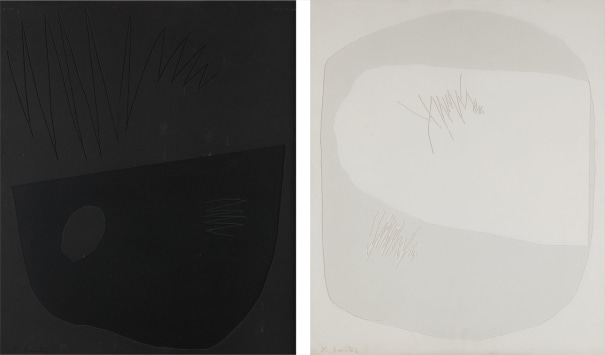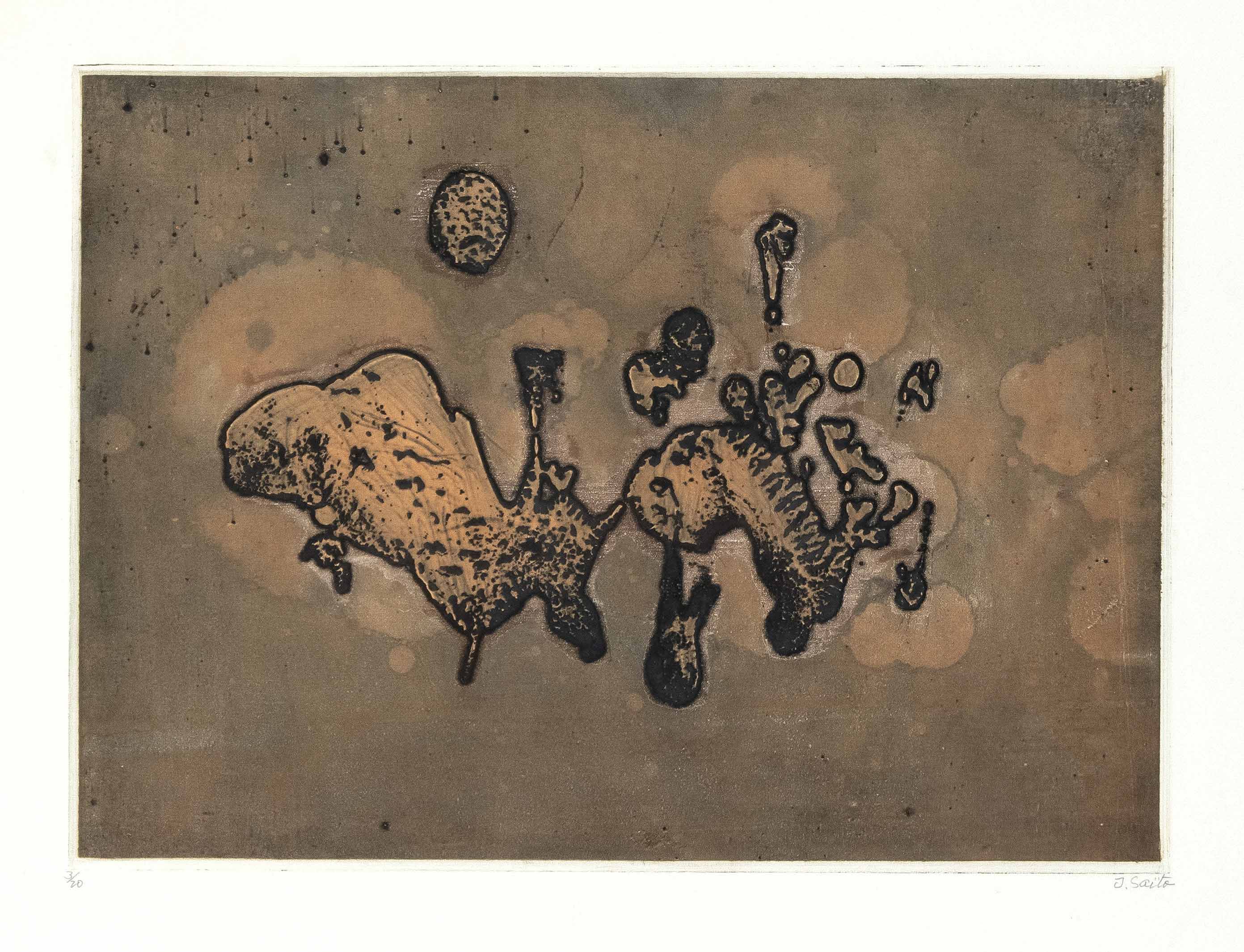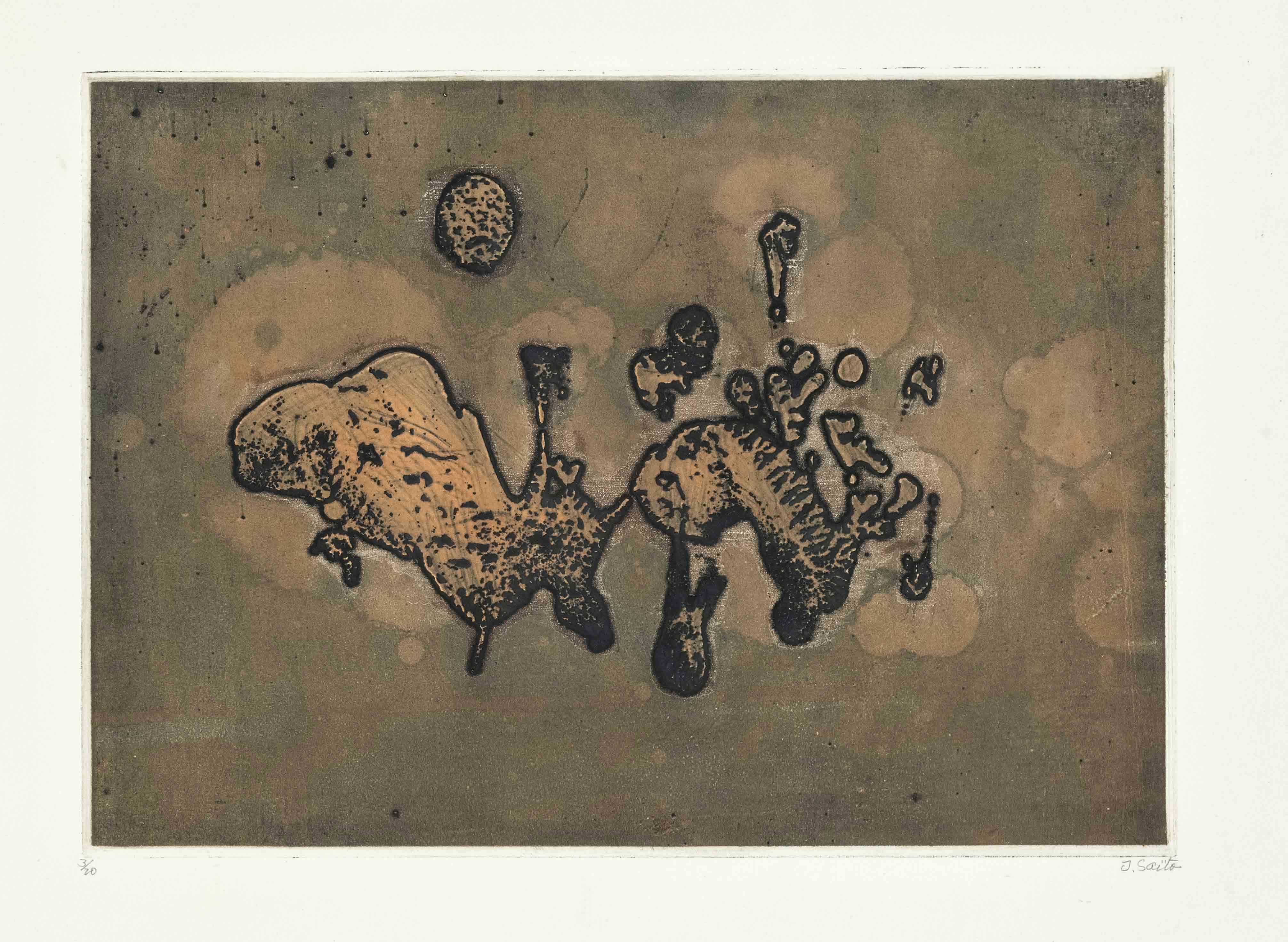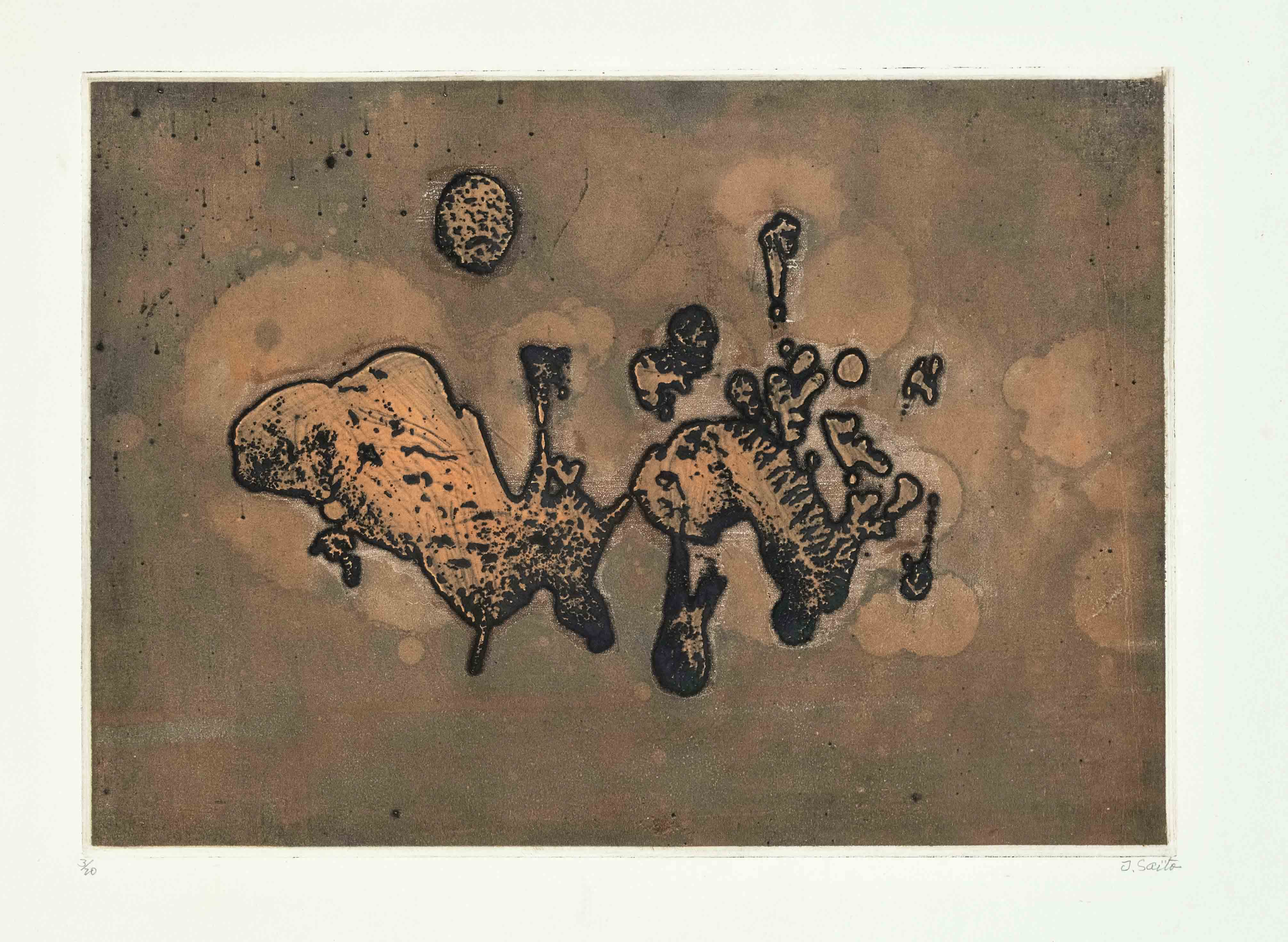Property from a Private Collection, Tokyo Yoshishige Saito Work 1963 oil on plywood, marked with electric drill 71 5/8 x 47 3/4 in. (181.9 x 121.2 cm) Signed and dated, "Y.Saito 63 斎藤義重 [Yoshishige Saito]" on the reverse.
Provenance Tokyo Gallery, Tokyo Sotheby's, New York, Japanese Works of Art, March 29, 1996, lot 42 Acquired at the above sale by the present owner Exhibited Lausanne, Palais de Rumine, Lausanne Cantonal Museum of Fine Arts, Premier Salon International de Galeries Pilotes, June 20 - September 22, 1963 Munich, Galerie Friedrich + Dahlem, Yoshishige Saito, April 15 - May 17, 1964 Oslo, Kunstnernes Hus, Internasjonal Kunst i Norsk Eie, November 6 - November 28, 1971 Tokyo, Tokyo Metropolitan Museum, Saito Yoshishige, February 9 - March 25, 1984, then traveled to Tochigi, Tochigi Prefectural Museum of Fine Arts (April 7 - May 6, 1984), Hyogo, Museum of Modern Art Hyogo (May 19 - June 24, 1984), Okayama, Ohara Museum of Art (July 3 - August 5, 1984), Fukui, Fukui Fine Arts Museum (August 11 - September 2, 1984) Literature N. Yusuke (ed.), "Yoshishige Saito", Mizue, July, no. 880, 1978, p. 39, no.110 Saito Yoshishige, exh. cat., Tokyo Metropolitan Museum, 1984, pp. 92-93, no.150 Catalogue Essay Yoshishige Saito was born at the cusp of the Meiji (1868–1912) and Taisho (1912–26) periods, two of the eras in early twentieth century Japan that marked the conclusion of the first phase of the country's fervent Westernization and industrialization and the beginning of its embrace of decadent modernity. Already as a teenager, Saito showed a great interest in art, particularly painting, and was exposed to a wide range of experimental visual and performing arts, literature, and film. His encounter with Japan’s early avant-garde movement MAVO in 1923 was the first turning point in his formative years. Led by Tomoyoshi Murayama (1901–1977) who recently returned from Weimer Germany, MAVO proposed an explosive alternative to the tame academicism of Japanese modern art of the time. Their activities included the incorporation of everyday materials into art, experimental theater and happenings, as well as socially engaged design and architecture projects, all of which set a precedent for the postwar blossoming of the Anti-Art movement from the late 1950s. Saito was awe-struck by Murayama’s uninhibited creative imagination and from the mid-1920s to around 1930 he nearly abandoned his practice in painting, spending much of his time on critical writing. During the 1930s, inspired by Russian Constructivism, Saito resumed his work as an artist, producing relief paintings and sculptures whose geometric quality proved consistently important to the artist as it resurfaced repeatedly in his postwar creations like Work from 1963 and in many other installation works produced in his last years. However, in the decade imminently facing the start of World War II, Saito’s unconventional three-dimensional works using plywood, strings, and plastic placed him against the conservatism of officially administrated exhibitions. Rather than compromising under the circumstances, the challenge only encouraged him to embark on a life-long search for the expression that lies between the realm of painting and sculpture. Similar to his friend and contemporary Jiro Yoshihara (1905–1972), who founded the Gutai Art Association to lead a new generation of avant-garde artists in the postwar years, Saito was a crucial teacher to many younger artists and transmitted the legacy of prewar vanguard movements to the new era of avant-gardism. At the same time, Saito attained critical acclaim with a series of plywood-based works of the late 1950s to the 1960s. The momentum of this achievement came with the second turning point in his life—a trip to Italy for his participation at the thirtieth Venice Biennale in 1960. Saito discovered the works of Lucio Fontana that confirmed the global relevancy of Saito’s quest as an artist—to find the space where the distinction between the two-dimensional and the three-dimensional is annihilated for the sake of a new time-space relation. It was this absolute confidence in his own mission that led him to boldly cut into a surface of plywood with an electric
Property from a Private Collection, Tokyo Yoshishige Saito Work 1963 oil on plywood, marked with electric drill 71 5/8 x 47 3/4 in. (181.9 x 121.2 cm) Signed and dated, "Y.Saito 63 斎藤義重 [Yoshishige Saito]" on the reverse.
Provenance Tokyo Gallery, Tokyo Sotheby's, New York, Japanese Works of Art, March 29, 1996, lot 42 Acquired at the above sale by the present owner Exhibited Lausanne, Palais de Rumine, Lausanne Cantonal Museum of Fine Arts, Premier Salon International de Galeries Pilotes, June 20 - September 22, 1963 Munich, Galerie Friedrich + Dahlem, Yoshishige Saito, April 15 - May 17, 1964 Oslo, Kunstnernes Hus, Internasjonal Kunst i Norsk Eie, November 6 - November 28, 1971 Tokyo, Tokyo Metropolitan Museum, Saito Yoshishige, February 9 - March 25, 1984, then traveled to Tochigi, Tochigi Prefectural Museum of Fine Arts (April 7 - May 6, 1984), Hyogo, Museum of Modern Art Hyogo (May 19 - June 24, 1984), Okayama, Ohara Museum of Art (July 3 - August 5, 1984), Fukui, Fukui Fine Arts Museum (August 11 - September 2, 1984) Literature N. Yusuke (ed.), "Yoshishige Saito", Mizue, July, no. 880, 1978, p. 39, no.110 Saito Yoshishige, exh. cat., Tokyo Metropolitan Museum, 1984, pp. 92-93, no.150 Catalogue Essay Yoshishige Saito was born at the cusp of the Meiji (1868–1912) and Taisho (1912–26) periods, two of the eras in early twentieth century Japan that marked the conclusion of the first phase of the country's fervent Westernization and industrialization and the beginning of its embrace of decadent modernity. Already as a teenager, Saito showed a great interest in art, particularly painting, and was exposed to a wide range of experimental visual and performing arts, literature, and film. His encounter with Japan’s early avant-garde movement MAVO in 1923 was the first turning point in his formative years. Led by Tomoyoshi Murayama (1901–1977) who recently returned from Weimer Germany, MAVO proposed an explosive alternative to the tame academicism of Japanese modern art of the time. Their activities included the incorporation of everyday materials into art, experimental theater and happenings, as well as socially engaged design and architecture projects, all of which set a precedent for the postwar blossoming of the Anti-Art movement from the late 1950s. Saito was awe-struck by Murayama’s uninhibited creative imagination and from the mid-1920s to around 1930 he nearly abandoned his practice in painting, spending much of his time on critical writing. During the 1930s, inspired by Russian Constructivism, Saito resumed his work as an artist, producing relief paintings and sculptures whose geometric quality proved consistently important to the artist as it resurfaced repeatedly in his postwar creations like Work from 1963 and in many other installation works produced in his last years. However, in the decade imminently facing the start of World War II, Saito’s unconventional three-dimensional works using plywood, strings, and plastic placed him against the conservatism of officially administrated exhibitions. Rather than compromising under the circumstances, the challenge only encouraged him to embark on a life-long search for the expression that lies between the realm of painting and sculpture. Similar to his friend and contemporary Jiro Yoshihara (1905–1972), who founded the Gutai Art Association to lead a new generation of avant-garde artists in the postwar years, Saito was a crucial teacher to many younger artists and transmitted the legacy of prewar vanguard movements to the new era of avant-gardism. At the same time, Saito attained critical acclaim with a series of plywood-based works of the late 1950s to the 1960s. The momentum of this achievement came with the second turning point in his life—a trip to Italy for his participation at the thirtieth Venice Biennale in 1960. Saito discovered the works of Lucio Fontana that confirmed the global relevancy of Saito’s quest as an artist—to find the space where the distinction between the two-dimensional and the three-dimensional is annihilated for the sake of a new time-space relation. It was this absolute confidence in his own mission that led him to boldly cut into a surface of plywood with an electric
.jpg)
.jpg)
.jpg)







.jpg)

Try LotSearch and its premium features for 7 days - without any costs!
Be notified automatically about new items in upcoming auctions.
Create an alert